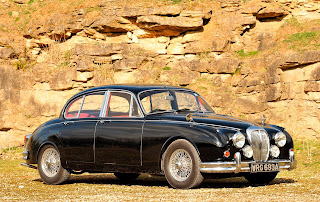Mad (pronounced mad)
(1) Mentally
disturbed; deranged; insane; demented.
(2) Enraged;
greatly provoked or irritated; angry.
(3) As
madman or (metaphorically) mad dog, a person abnormally furious; ferocious (and
can be applied literally to animals (mad bull etc), especially dogs afflicted with
rabies (a rabid dog).
(4) Extremely
foolish or unwise; imprudent; irrational.
(5) Wildly
excited or confused; frantic (often as “in mad haste”).
(6) Overcome
by desire, eagerness, enthusiasm etc; excessively or uncontrollably fond of
(usually) someone; infatuated; (often as “madly in love”).
(7) Wildly
lively and merry; enjoyably hilarious.
(8) Of
extremes in climatic conditions (of wind, storms, etc), furious in violence.
(9) An
angry or ill-tempered period, mood, or spell.
(10) As MAD, the
acronym for mutually assured destruction: a theory of nuclear warfare deterrence
whereby each side in a conflict has the capacity to destroy the other in
retaliation for a nuclear attack.
(11) The
acronym for the Militärischer
Abschirmdienst, a counterintelligence agency of the German military
(essentially the successor to the old Abwehr
(1920-1944)).
(12) The
acronym, in admiralty administration, for the Maritime anomaly detection in
Global Maritime Situational Awareness, for avoiding maritime collisions
(13) The
acronym, in astronomy, for the Magnetic anomaly detector which detects
variations in Earth's magnetic field.
(14) The
acronym, in high-energy physics, for the Methodical Accelerator Design, a CERN
scripting language used in particle acceleration.
Pre 900:
From the Middle English mad
(adjective) & madden (an intransitive
verb, derived from the adjective), from the Old English gemǣd, past
participle of gemǣdan (to make mad), akin to gemād (troubled in mind; demented, insane, foolish). It was cognate with the Old Saxon gemēd, the Old Norse meitha (to hurt, damage) and the Old
High German gimeit (foolish, silly,
crazy). In the Old English, gemǣded was
the past participle of gemǣdan (to render insane). As an adjective, the comparative is madder
and the superlative maddest but the strangest adjectival form is probably the
very English maddish, suggesting some state between displeased and actually
mad. The ultimate
root of the Old English forms was the Germanic adjective gamaidaz (changed for the worse, abnormal), the element “maid” from
the primitive Indo-European moi-, a
variant of the root mei- & moi- (to change, exchange, go, move),
extended with a dental suffix (-d in Germanic; -t elsewhere). The same suffixed variant moit- appears in the Latin mūtāre
(to change, exchange, give and receive in exchange), familiar in COVID-19-era
English as mutate. The Sicilian Greek (a
fork by virtue of geography always most likely to be influenced by Latin) has
the noun moîtos (thanks, favor,
reward), presumably a borrowing from the Old Latin moitus. Mad is an adjective, verb & adverb; madder & maddeningness are nouns, adjectives & verbs, maddest, maddish & maddening are adjectives, madly & maddeningly are adverbs and madden & maddens are verbs; the noun use of mad is non-standard.
The
synonyms for mad exist in its four senses (1) lunatic, maniacal, psychotic, crazed,
crazy, nuts, kooky, nutty, insane, (2) furious, exasperated, livid, raging,
wrathful, irate, (3) ill-advised; unsafe, dangerous, perilous & (4) absurd,
fantastic, delirious, wondrous. There is
much overlap in the synonyms, insane historically meant “not sane, mentally
unstable” but is now popular with the Instagram generation as a general
expression of approval and "bonkers", while still meaning “not sane, mentally
unstable” also (except in the US) has come to be used in an entirely
non-pejorative way to suggest something astonishing in the sense of something
or someone verging on the irrational but in some way inspiring; absurd works in
a similar way.

Bonkers:
2023 Dodge Challenger SRT Demon 170.
Because
it makes Greta Thunberg (b 2003) mad, the likes of the SRT Demon 170 won’t be
seen again but an off-the-shelf machine which can generate 1,025 horsepower makes a fine swansong. To make Ms
Thunberg madder still, it’s noted the induction system is capable of providing
more fuel flow per minute than the average US showerhead and in a nice touch
the purchaser will receive a commemorative Demon 170 decanter set. Thousand horsepower cars for the street have
traditionally been the preserve of madmen but mad women should be encouraged to
give one a try.
The
word appears often in idiomatic use including “mad as a March hare” which
alluded to hares becoming especially active in spring their mating season; “mad
as a meat axe”, an especially evocative piece of Australian slang which is
self-explanatory to anyone who has seen an un-skilled operator use a meataxe on
a carcass and “barking mad”, the origin of which is mysterious. The best story links it with the existence of
a medieval lunatic asylum in the grounds of the royal monastery Barking Abbey
(located in what is now the London borough of Barking and Dagenham) but there’s
no evidence of use before the early twentieth century and most etymologists have
concluded there’s a link with the idea “mad dogs” incessantly bark. The London slang use suggesting someone is “three
stops past Barking” is thought to have be an opportunistic adoption referencing
the “barking” and in the vein of something like “a picnic short of a sandwich” which
suggests some degree of mental incapacity.
There was even “shorthand slang” based on this idea: were one to be
called “daggers”, it meant one was “three stops past Barking”, Dagenham being three
stations beyond Barking on the London Underground.
The
original meaning of mad was “insane, demented, disturbed of mind”, a sense
inherited with the word from the Germanic forms. The progression in meaning seems to have
begun circa 1300 when the senses (1) “mad dog” (dog afflicted with rabies
(rabid)), (2) “foolish or unwise” and (3), “overcome by desire or eagerness” emerged;
the meaning “enraged, angry” not recorded until circa 1400. This sense of mad quickly became the usual
colloquial term in the United States whereas “angry” long persisted as the popular
form elsewhere in the English-speaking world although the increasing US
cultural influence noted since the mid-twentieth century makes these
distinctions probably less noticeable.
The sense “wildly lively, merry” is said to be an innovation of African-American
English associated with jazz and dating from the 1940s. For those learning English, “mad” must seem a
strange word given the social difficulties engendered if one accidently mixes
up being “mad about you” with “mad at you”. So students should be given practical examples such as: "I am mad about him" (I would like to enjoy intimacy with him); "I am mad at him" (I am angry with him or I would like to kill him); "He is mad" (he appears mentally unstable).

Lindsay Lohan and her lawyer in court, Los Angeles, December 2011.
Another
thing for them to learn was that wad was one of those words listed as a
class-identifier by Professor Alan Ross (1907-1980), Professor of Linguistics
at the University of Birmingham who in 1954 coined "U" (upper-class)
and "non-U" (non-Upper-Class) to describe the differences social
class makes in their use of English.
While his article included differences in pronunciation and writing
styles, it was his list of variations in vocabulary which attracted most interest. One difference he noted was the upper-class
call the obviously unstable “mad” whereas the lower classes tend to label them
“mental”. Professor Ross published his
illustrative glossary "U" and "non-U", differentiating the
speech patterns in English social classes, in a Finnish academic journal and
used extracts from Nancy Mitford’s (1904–1973 and the oldest of the Mitford
sisters, all but one of whom society's more conventional types were apt to label "mad") 1945 novel The Pursuit of Love
to provide examples of the patterns of speech of the upper class. This pleased Nancy Mitford who interpolated
the professor’s work into an article about the English gentry she was writing
for Stephen Spender's (1909-1995) literary magazine Encounter (1953-1990).
Although not best-pleased that her discussion of the Ross thesis was the
only part of her piece to attract attention, more amusing was the subsequent
re-publication in 1956 in her Noblesse Oblige:
an Enquiry into the Identifiable
Characteristics of the English Aristocracy which, augmented with
contributions from John Betjeman (1906–1984) and Evelyn Waugh (1903–1966),
meant that for decades she was the acknowledged authority on upper-class
speech, manners and ways. Her
class-conscious readers had taken it all more seriously than she had intended.

He must have been mad: New
Zealand-born political cartoonist David Low’s (1891-1963) take on the announcement
from Berlin that Rudolf Hess (1894–1987; Nazi deputy Führer 1933-1941) had gone
mad, Daily Express 15 May 1941. Clockwise
from left: Hermann Göring (1893–1946; leading Nazi 1922-1945, Hitler's
designated successor & Reichsmarschall 1940-1945), Adolf Hitler (1889-1945;
Führer (leader) and German head of government 1933-1945 & head of state
1934-1945), Dr Robert Ley (1890–1945; head of the Deutsche Arbeitsfront (German
Labour Front) 1933-1945), Heinrich Himmler (1900–1945; Reichsführer SS
1929-1945), Dr Joseph Goebbels (1897-1975; Nazi propaganda minister 1933-1945)
and Joachim von Ribbentrop (1893–1946; Nazi foreign minister 1938-1945).
On 10 May
1941, Hess, a skilled pilot, wholly on his own initiative, undertook a secret
flight to Scotland where his plan was to negotiate an end to the hostilities
between the UK and Germany. This was
only days before the German invasion of the Soviet Union (something of which Hess
made no mention while being interrogated) and his motivation was to avoid what
he (correctly) regarded as the major strategic mistake of confronting a
two-front war. The British government,
interested only in the eradication of Nazism declined to negotiate and Hess was
locked up, including for some two weeks enjoying the rare honor of being held
in the tower of London. News of Hess’s
flight had sent shockwaves through the Nazi high command, then about to embark
on the greatest invasion in history.

Rudolf Hess (left) and Adolf Hitler (right), Sturmabteilung (the SA (Storm Troopers, the Nazi Party's original paramilitary formation) parade, Nuremberg 11 September 1938; the car is a Mercedes-Benz 770K (W07, 1930–1938).
After for a
while clinging to the hope his erstwhile deputy might have crashed into the
ocean, Hitler, upon hearing the BBC (British Broadcasting Corporation) confirm
the curious arrival on Scottish soil, made the sudden decision to issue a
statement claiming Hess had gone mad, the consequence of injuries suffered
during World War I (1914-1918) and falling under the influence of fortune
tellers. This was done without
consulting the propaganda minister and Goebbels was aghast the regime had just
admitted its deputy leader was a madman; he feared how the British would
exploit the revelation, knowing what he’d do in their place. However, aware through intelligence sources
the invasion of Russia was nigh, the British had no wish to convey to Moscow
the impression they were seeking to make peace with the Nazis and the bizarre
business soon vanished from the news, coming to be known as a “nine day wonder”;
the only one upon whom it appeared to leave a lasting impression was comrade Stalin
(1878-1953; Soviet leader 1924-1953) who to his dying day remained suspicious elements
in the UK were associated with the flight of the “motorized Parsifal”.

Hitler on a walk with Helga Goebbels (1932-1945), 1936. She was Joseph Goebbels' oldest child.
The other
immediate effect was the Nazis, in a typical reaction, organized a crackdown on
the fortune tellers but in Berlin, the sardonic humor soon surfaced and a joke
circulated in which Hess was taken to meet Winston Churchill (1875-1965; UK
prime-minister 1940-1945 & 1951-1955) who asked: “So you’re the madman?” to which
he received the reply: “No, I’m only his deputy.” Hess died by suicide in Spandau prison in
1987 after 46 years in captivity, outliving Göring (committed suicide in 1946
just before he was to be hanged for war crimes), Hitler (committed suicide in
1945 in the Berlin Führerbunker with
the Red Army’s tanks only streets away), Ley (committed suicide in 1945 while under
indictment as a war criminal), Himmler (committed suicide in 1945 after being
arrested by the British), Goebbels (committed suicide in 1945 (with his wife)
after they’d murdered their six children (aged between 4-12)) and von
Ribbentrop (hanged in 1946 as a war criminal.
Until
probably sometime in the nineteenth century, for all but a few specialists, the
condition of madness was relatively simple: people were mad or sane and while
it was noted one could become the other, once labeled as mad one was by most, probably
always thought mad and the punchy succinctness of the word could produce a memorable phrase such as the one used by Lady Caroline Lamb (1785–1828) to describe her lover, Lord Byron (George Gordon Byron 1788–1824): "Mad, bad, and dangerous to know". The only widely
observed nuances were behavioral and that was because madness was an
observational diagnosis; there were those who were mad, slightly mad, quite mad
and barking mad, hardly clinically exact descriptors but it’s doubtful many
misunderstood what was being conveyed.
Modernity’s advances in neurology and pharmacology allowed the creation
of psychiatry which began to gain a grudging acknowledged respectability in the
medical profession around the turn of the century and it been a growth industry
since. The American Psychiatric
Association’s (APA) Diagnostic and Statistical
Manual of Mental Disorders (DSM), when first published (DSM-I, 1952) was a
slim volume of 130 pages which listed 106 mental disorders but by the time the
fifth edition (DSM-5, 2013) was released it had grown to 947 pages although
interestingly, the number of specific diagnoses was reduced from 172 in DSM-IV (1987)
to 157, something of an achievement given 15 new mental illnesses were
added. It is though bit of a
definitional minefield and there are those who suggest that once deconstructed, there are really
over 300 identifiable conditions, some of the official 157 categories better
thought of as groups or clusters.
However the count is done, nobody is expecting DSM-6 to contain fewer
pages, whatever method is used to define the conditions so it seems there must
been more to madness than once convenient mad-sane binary.
How
much the proliferation of diagnosed madness is mission-creep and how much
better understanding is a debate, mostly outside the profession. Some of it is certainly an attempt to secure
market-share for the psychiatrists, some “conditions” once thought normal as
part of the spectrum of the human condition now listed as a disorder to be
referred for treatment and in some cases this is doubtlessly a good thing although
quite how reassuring a diagnosis of “generalized anxiety disorder” (GAD) is for
a patient may be questionable. GAD may
also be overkill, the psychoanalyst having long supplanted the priest for those
who can afford the hourly-rate, market share seems well secured.

Some of
Louis Wain's drawings of cats, all reputed to date from his time of incarceration
in a mental hospital during the 1930s.
The English artist Louis Wain (1860–1939)
was a noted painter of cats, sometimes naturalistic, sometimes stylized and
often anthropomorphic. In his sixties he
was diagnosed with schizophrenia and confined to a series of mental institutions,
settling eventually in Napsbury Hospital, north of London. By the standards of the time it was a
convivial place with a park and a colony of cats and while his condition
worsened, the frequency of his psychotic episodes decreased but drawings of
cats he continued to produce became increasingly abstract, intricate and
bizarre. After 1930, he would never
again leave Napsbury and there, in 1939, he died aged 78. For a
long time his paintings of cats have been used to illustrate an artist's
descent into madness, a theme popular in those circles in which the notion of the "disturbed genius" is a cult. However, the thesis has been questioned,
notably on the technical ground of chronology; being undated, it can't be
guaranteed the sequence of drawings as they're usually assembled are an
accurate lineal progression of his work and doubt has been case even on the diagnosis of schizophrenia, some
speculating the then not well understood medication used in the era to treat
the condition may have contributed to his symptoms.




















